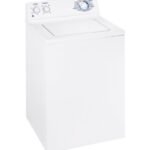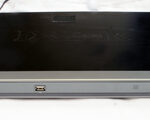Prefatory note: You can find great deals on this DVD player via various vendors. For example, as of this writing, Bestbuy.com has this model “on sale” for only $59.49 (You must “temporarily place the item in your shopping cart” to see its discounted price). I phoned my neighborhood Best Buy store (which was selling this unit for around $75), and they readily agreed to match the on-line price. (Alternatively, I could’ve simply placed my order on-line and specified “in-store pickup” at that store). Analogously, CircuitCity.com has approximately the same deal (including the availability of “in-store pickup”). And even Amazon.com has a comparable deal (minus the “same-day, in-store-pick-up” option, of course).
My already substantial appreciation for Philips’ DVD players has further increased with my recent purchase of this model. Since January 2006, I’ve pretty regularly used the (now discontinued) model DVP642, which — with its low-profile console and comparable media-compatibility — is somewhat similar to this DVP5982. The previously popular DVP642 continues to perform flawlessly for me. [Note: I have not owned or tested the immediate predecessor to this model DVP5982, namely, Philips’ extremely similar model DVP5960, whose console isn’t as dark, and which can still be purchased for about the same price as this “all-black” DVP5982.]
But, for my primary “entertainment-center” setup, I’d been using a Toshiba SD-1800 DVD player. When the latter product recently “died” (after a mere four and a half years of generally good service), it didn’t take me long to select this Philips DVP5982 as its replacement. Not only is this unit sort of a new-and-improved “first cousin” of my aforementioned Philips DVP642 model, but its “all-black” console (as opposed to the silvery hue of the DVP642) better harmonizes with the adjacent, preexisting Sony and JVC components within my armoire.
NOTE: Disregard any product photos that make this DVP5982 appear to be a sort of two-toned “black and charcoal”. In reality, the main console is ALL-black, excepting a few minor, silvery highlights (e.g., the disc-insertion door and the several basic operational buttons on its face).
Whatever disc you insert, the Philips DVP5982 is virtually sure to play it!
Don’t you just hate it when your DVD player doesn’t reliably load and/or play that occasional, inexplicably problematic DVD (not to mention various, less commonly used digital video/audio formats)? Well, that’s much less likely to happen with this machine [not to mention Philips’ silvery, discontinued model DVP642, which can still be easily found brand-new via certain vendors and/or eBay]. Not only can this Philips’ model DVP5982 play various disc formats that the average consumer–including me–will seldom, if ever, use, but even a few seemingly ordinary DVDs that wouldn’t load/play reliably on my prior Toshiba or Sony units were nicely tolerated by this Philips unit.
In addition to standard (and any format of recordable) DVDs, this unit can play such video/audio formats as VCD, DivX, photo CD, JPEG/TIFF, audio CDs, MP3, and more.
You do, however, sometimes have to be a bit patient during the initial “loading” process after inserting certain discs; indeed, this model DVP5982 occasionally takes noticeably (but tolerably) longer to “load” than does the aforementioned DVP642. But once the initial “loading” process is finally executed, the displayed results are eminently gratifying. [Note: The “loading” process virtually always does eventually succeed and seldom takes longer than about 20 seconds to (in rare instances) about one minute.]
Three noteworthy differences between this model versus Philips’ earlier DVP642:
1. Hey, Philips! What happened to “frame-advance”?!
While watching movies, do you ever press “pause” and then “advance” (or “reverse”) the video precisely one frame at a time? If your answer is no, then you’ll likely be fully satisfied with this model DVP5982 DVD player. I myself am a teensy bit perturbed with Philips’ designers for omitting that feature (which was included with their earlier model DVP642). Nevertheless, “frame-advance” capability isn’t that big a deal to me (you can generally “make do” by simply repeatedly–and rapidly–tapping the conspicuous “PLAY/PAUSE” key–albeit that approach only works in the forward direction). Evidently some profit-hungry person(s) at Philips decided that “frame-advance” capability doesn’t matter enough (to most consumers) to justify its additional manufacturing cost.
2. Thanks, Philips, for (belatedly) getting “up to speed”!
Arguably the greatest leap forward of this model involves its “high-speed search” capability. With Philips’ earlier DVP642, the maximum speed (for either “fast-forwarding” or “rewinding”) was an anemic 8X. (That was basically the biggest shortcoming of that old model.) Thankfully, this model DVP5982 has a maximum search speed of 32X (its selectable speeds are 2X, 4X, 8X, 16X and 32X), which more than suffices for nearly all consumers’ purposes.
3. Still more thanks to Philips for redesigning the “resume-playback” feature!
With Philips’ earlier model DVP642, while initially “loading” a DVD movie, you had to wait till you saw the word “loading” appear on the TV screen, and then you could press the “PLAY” key to resume playback from where you’d previously stopped the movie. [But if you forgot to press the “PLAY” key (or didn’t do so soon enough) during the initial loading process, the old model DVP642 would start playing the DVD from the very beginning.]
Thankfully, this model DVP5982 automatically resumes playback from the point where the movie was previously stopped. But if you’d prefer to view the movie from the very beginning, you can press the “PREV” (“previous”) key (i.e., the “backward-skip” key) during the initial loading process (an on-sceen prompt conveniently reminds you of that). I much prefer this redesigned, foolproof, automatic (but easy-to-override) “resume-playback” feature, the likes of which many other DVD-player models have long implemented.
Video/audio quality (and connections):
Whether we’re talking Hollywood blockbusters or what have you, DVDs’ on-screen colors are bright and distinct via Philips’ DVP5982 DVD player; resolution is as sharp as the given media will allow. Mind, I myself don’t (yet) use a digital TV but rather a circa-2003 JVC 36-inch “enhanced-analog” set (which, via “component-video” inputs, provides some additional lines of resolution per inch and thus produces a reasonably sharp–ostensibly “almost-digital-quality”–image). [For whatever it’s worth, other reviewers have reported that their fully digital, giant-screen TVs are wonderfully compatible with this Philips DVP5982 using its HDMI (digital video-plus-audio output) connectivity capability. I myself remain satisfied using the aforementioned “component-video” inputs (separate green, red, and blue jacks) and my 36-inch screen.]
Note: There’s no “optical audio out” jack. For high quality audio, I use the single digital-audio “coaxial” (silver RCA) jack, which is located directly adjacent to the two conventional (red and white RCA) analog-audio jacks on the unit’s rear panel. The resulting sound is excellently dynamic, especially using Dolby 5.1-quality DVDs. With any good “five-satellites-plus-subwoofer” speaker setup, this DVD player can provide a thrilling listening experience.
If you want to take advantage of this unit’s better-than-average-quality video and audio capabilities, you’ll need to spend some extra money for the appropriate cables (if you don’t already have ’em). [The only cable included with this DVD player is a typical three-pronged, “red, white, and yellow” analog cable, each end of which comprises one ordinary composite-video (yellow-RCA) plug and two (red-and-white-RCA) plugs for stereo audio.]
The console:
Much like Philips’ earlier model DVP642 DVD player, this model DVP5982 features a tastefully sleek “low-profile” console measuring a mere 1.5 inches tall (by about 17 inches wide and 7.75 inches deep). Again, this DVD player (unlike its mostly “light-gray” remote) is basically “all-black”, distinguishing it from the “all-silver” DVP642.
From left to right, the ultra-slim console’s front controls (shiny, silvery pushbuttons) include: “power” (labeled “STANDBY-ON” and involving a little red-LED that glows reasonably unobtrusively whenever the unit is switched “off”, i.e., is in “standby” mode); “OPEN/CLOSE” (directly to the right of the disc-tray door); “HD UPSCALE”; “PLAY/PAUSE”; and “STOP”.
Contrasted with the earlier Philips model DVP642, the DVP5982 disc tray feels slightly flimsier, though I suspect it will last approximately as long provided you’re sensibly gentle with it.
More significantly, the DVP5982 disc tray takes noticeably longer to open (than does that of the earlier model DVP642) after you press the eject button on the face of the console (or after you’ve held down the “STOP” key on the remote). The relative sluggishness of this model’s disc tray amounts to an inexplicable (but tolerably small) step backward.
The remote (for which two “AAA” batteries are included):
Let’s face it: your experience and satisfaction with any DVD player will be significantly affected by the quality of its remote’s keypad layout, not to mention the remote’s general “feel” in your hand. On the one hand (no pun intended), the DVP5982’s (mostly “light-gray”) remote–at about five inches tall by two inches wide by 3/4 of an inch thick–will strike some users as being a bit smallish, while others (including me) will find its compactness a welcome change from other models’ unnecessarily large handsets.
More significantly, the remote’s keypad layout is considerably more “intuitive” than that of Philips’ earlier, DVP642 model. The four primary “cursor-control” (on-screen menu-selection) keys are now conspicuously separated from all other keys, making it much easier to quickly position your thumb and select on-screen-menu options.
A still nicer improvement involves the placement of the “PLAY”, “PAUSE”, and “STOP” keys. With the old (model DVP642) remote, there were three separate (and too closely adjacent) keys for those respective functions, and they were confusingly adjacent not only to each other but also to the four primary “cursor-control” keys. It was a continual hassle to find the right key–especially in a darkened room. But the new (model DVP5982) remote uses a single–conspicuously larger and isolated–combination “PLAY/PAUSE” key for the first two functions, which makes it much easier to distinguish the nearby, dedicated “STOP” key.
Then, too, the “DVD-menu” key is now in the extreme upper-left portion of the keypad, making it much easer to find that highly useful key in a darkened room.
However, like the earlier model DVP642, this DVP5982 lacks any dedicated “fast-forwarding” or “rewinding” keys. Instead, the “left” and “right” keys of the primary “cursor-control” foursome serve double duty in this regard (don’t fret: there’s no “function-mode selector” switch to hassle with; everything’s easy and automatic). This “multifunction” approach is by no means difficult to adjust to after a mere moment of practice, and I don’t consider it a drawback.
Analogously, there are no dedicated “slow-motion” keys (forward or reverse). Instead, the “up” and “down” keys of the primary “cursor-control” foursome serve double duty in this regard. Again, this “multifunction” approach is actually quite easy to get used to after a moment. In fact, a gratifying fringe benefit is the noticeably “less cluttered” keypad layout.
On the other hand, the model DVP5982 remote continues to share one of the old model DVP642 remote’s most controversial idiosyncrasies: there’s no dedicated “eject” or “open” key. If you prefer to use the remote (instead of the main console’s own dedicated “OPEN/CLOSE” button) to open or close the disc-tray door, you must hold down the “STOP” key for several seconds. Trust me, this concept will seem entirely second nature after a few moments’ familiarity. My only noteworthy objection to it is that you must indeed patiently wait up to several seconds for the tray to thusly open (or close). That this tolerably minor idiosyncrasy is virtually my only ongoing dissatisfaction with this product speaks pretty well for the model DVP5982’s overall design and ease of use.
The user manual:
The 163-page manual comprises English, French and Spanish sections. (The first 57 pages are in English.) The text and illustrations are generally very well written/rendered. For example, the various illustrations involving the remote’s keypad layout and the console’s rear-panel connectors are all pretty satisfyingly straightforward.
Additionally, there are the usual, separate, two-sided, “Quick Start Guide” sheets in English, French and Spanish.
I didn’t really need to consult any of this documentation to set up the unit within my home-theater armoire. The rear panel’s jacks are all sufficiently labeled, as are the various operational buttons and keys on the face of the unit and the remote.
The upshot:
For less than sixty dollars, you aren’t likely to find any other model so media-compatible, attractively styled, and downright reliable as the Philips DVP5982.
Like its fairly comparable, now-discontinued cousin (Philips’ model DVP642), this amazing machine can routinely play “problem” discs that would choke most competing DVD players. Just study the DVP5982’s complete specifications via any authorized vendor, noting especially the range of compatible media types, and contrast it with other models at its (or perhaps any) price level. Frankly, regardless of such “official” media-compatibility specs per se, actual hands-on experience has shown me that in those situations where other DVD-player models inexplicably fail to load and play particularly problematic discs, the Philips DVP5982 really shines. Given that, and given the DVP5982’s low cost and streamlined stylishness, it’s surely the most powerfully multifaceted and appealing DVD player for the money.




